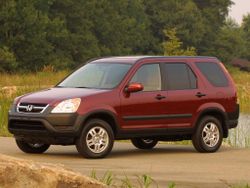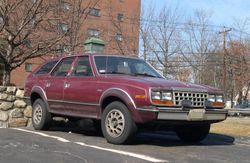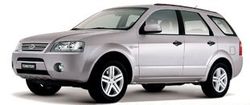Crossover SUV
Car Show
Crossover SUV
 The Honda CR-V is a crossover SUV based on the Honda Civic platform.
The Honda CR-V is a crossover SUV based on the Honda Civic platform.A crossover SUV (also called
CUV for Crossover
Utility Vehicule) or XUV (not to be confused with
GMC's Envoy XUV) is an
automobile
with a
sport utility vehicle appearance but is built upon a more economical and
fuel-efficient
car-based
platform.
History
 AMC Eagle
wagon, an early crossover model
AMC Eagle
wagon, an early crossover model
 Australian made
Ford Territory SUV
Australian made
Ford Territory SUV
The first of this class of vehicles was the 1957
Moskvitch 410, but a more well-known example is the AMC Eagle, which debuted in 1980. The Eagle combined
Jeep
4×4 off-road functionality with the
AMC
Concord car-based platform and bodywork. However, the Eagle suffered from
poor sales throughout its production, and it was discontinued in 1988.
In the 1990s, an SUV and
light
truck craze took hold of the North American vehicle market, catapulting what
once was a small piece of the market that was originally dedicated to farmers
and outdoorsmen to vehicles that were being used as
family cars,
to the extent that by the end of the decade, light trucks accounted for almost
50% of all new vehicle sales, and overwhelmingly the popularity of the SUV
segment was responsible for this shift in buying patterns.
Traditionally, SUVs were heavy-duty
truck-based appliances, with body-on-frame construction. In response to market demands, automakers had
been continually making each successive generation of their SUVs more and more
"car-like" but the inherent limitations of this configuration made them poorly
suited for their new primary function as family haulers.
Research showed that a vast majority of SUV owners never took their vehicles
off-pavement, much less used them for fording streams or climbing boulders,
which was their original raison d'etre. An opportunity to provide what this new
type of SUV owner actually wanted was seized.
Customers liked the idea of all-weather traction provided by four wheel
drive, the ability to haul large items or a good number of people, and enjoyed
the "commanding" seating position and sense of security that they believed the
mass of an SUV provided, but mostly they liked the implication of an active,
outdoorsy lifestyle that an SUV suggested, and that
minivans and
station wagons implicitly did not.
The Toyota Camry-based Lexus RX300 was introduced in 1999 and was an
instant success. It provided all of the aforementioned attributes that customers
were looking for in an SUV, but additionally provided car-like attributes such
as a smooth ride, (relatively) good handling, low step-in height and decent gas
mileage, all while providing the desired SUV psychological imagery.
The term "Cross-Over" was applied to the
Lexus RX300 to indicate its indeterminate status and was retroactively applied
to progenitor models such as the AMC Eagle and Subaru Outback. Given the inherent fuzziness of the "Crossover" designation,
and automakers' desire to introduce vehicles into this currently "hot" segment,
any number of improbable vehicles that are far removed from the original SUV
concept are grouped in this category. The designation now signifies almost any
non-truck based model that carries some form of SUV styling cues or attributes.
Advantages
Car-based crossover SUVs vehicles have three primary advantages over
truck-based SUVs:
- Handling - The unsafe handling characteristics of trucks with
respect to sudden, evasive maneuvers has been demonstrated and accepted.
Their high
center of gravity, tall tire sidewalls, and long-travel suspensions
(designed for heavy cargo and off-road use) make designing a truck-based SUV
to be resistant to rollovers extremely difficult. Car-based crossovers ride
lower and feature more road-appropriate suspension designs, that while
limiting their ultimate off-road utility makes them much more stable and
responsive.
- Economy - Car-based crossovers are much lighter than their
heavy-duty truck-based cousins. They also feature light-duty
all wheel drive or even just
two wheel drive rather than less-efficient and heavy four wheel drive,
and use lighter
unibody
construction as well as coming equipped with more practical
"on-road"-oriented
tires. As a
result, most crossovers get only slightly worse fuel economy than station
wagons and sedans based on the same platform owing primarily to the
fundamentally less efficient
aerodynamics of the SUV shape.
- Cost - Light-duty car components can be cheaper to build and in
fact, many modern crossovers are based on small economy cars, driving
underlying costs lower still.
Continuing proliferation
Given the market's demonstrated insatiable appetite for SUVs and SUV-like
vehicles, automakers have been scrambling to imbue the desired characteristics
(with varying success) to a wide range of disparate products from
station wagons such as the
Subaru Outback and the Audi Allroad to minivans like the Pontiac Montana SV6,
and the Mazda MPV All Sport, extending even to sedans like the Subaru Outback
SUS and Ford Five Hundred and running the gamut from entry-level, inexpensive
models like the Honda CRV to the luxurious and pricey Cadillac SRX.
Almost every automaker participating in the North American market has a
"crossover" vehicle, and the selection of choices has exploded. A short list of
current crossovers with their platform genealogy follows (similar vehicles are
grouped together):
| Model(s) |
Platform |
| Acura MDX and Honda Pilot |
Honda Accord |
| BMW X3 |
BMW 3-Series |
| BMW X5 |
BMW 5-Series |
|
Buick Rendezvous/Pontiac Aztek |
U platform (GM minivans) |
|
Cadillac SRX |
Sigma platform (Cadillac CTS & STS) |
|
Chrysler Pacifica |
Chrysler CS platform (Chrysler Town and Country/Dodge Caravan) |
|
Ford Escape/Mazda Tribute/Mercury Mariner |
Ford CD3 platform |
|
Ford Ecosport |
Ford Mk6 platform (Ford Fiesta) |
|
Ford Freestyle |
Ford D3 platform (Volvo S80) |
|
Ford Territory |
Ford Falcon |
|
Holden Adventra/HSV Avalanche |
Holden Commodore |
|
Holden Crewman/HSV Avalanche XUV |
Holden Commodore |
|
Honda CR-V and Honda Element |
Honda Civic |
|
Hyundai Tucson/Kia Sportage |
Hyundai Elantra |
|
Hyundai Santa Fe |
Hyundai Sonata |
|
Infiniti FX |
Nissan FM platform (Infiniti G35) |
|
Lincoln MKX |
Ford CD3 platform (Lincoln Zephyr/MKZ) |
|
Toyota Harrier/Lexus RX and Toyota Kluger/Highlander |
Toyota Camry |
|
Mitsubishi Endeavor |
Mitsubishi Galant |
|
Mitsubishi Outlander |
Mitsubishi Lancer |
|
Nissan Murano |
Nissan Altima |
|
Subaru Forester |
Subaru Impreza |
|
Toyota RAV4 |
Toyota Corolla |
|
Volvo XC90 |
Volvo P2 platform (Volvo
S80) |
See also
References
Home | Up | Sport utility vehicle | Crossover SUV
Car Show, made by MultiMedia | Free content and software
This guide is licensed under the GNU
Free Documentation License. It uses material from the Wikipedia.
|







